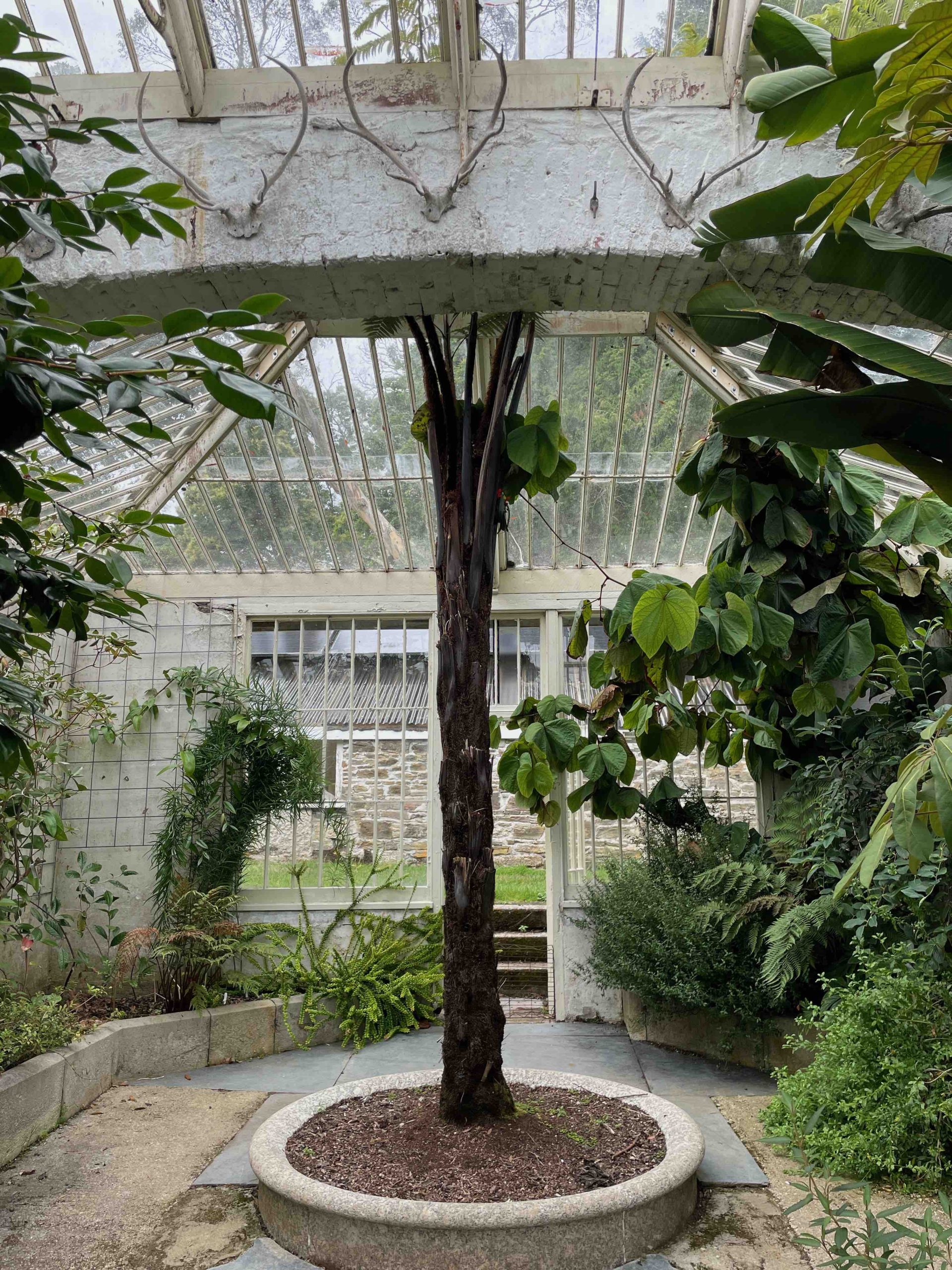Alison Agnew is the Roseland Online gardening feature writer. She is a retired biology lecturer and amateur, but long time, gardener and designer. She has a particular interest in the technical, aesthetic and health aspects of gardening.
On Sunday 6 August Alison’s own Roseland garden will be open to the public, for the National Garden Scheme. As well as a plant stand, teas, cakes etc, Lafafa Catering light lunches will also be available. Entry is £5 and the garden will be open from 11am to 5pm. It is well worth a visit – Crugsillick Manor, Ruan High Lanes, TR2 5LJ.
For this month’s article Alison champions trees and shrubs with a visit to one of Cornwall’s great gardens – Tregrehan.
We had summer visitors last week so I took a whole week off the garden and managed to visit Tregrehan Gardens. Managed it had to be – at this time of the year Tregrehan is only open on Wednesday afternoons from 1 to 4.30pm – a pretty tight window for such a large garden.
It is open 4 days a week in spring because, like many of the larger Cornish gardens, Tregrehan is known for its Magnolias, Rhododendrons and other spring-flowering trees. I think they are missing a trick – the arboretum has the most amazing variety and number of exotic shrubs and trees and deserves a visit at any time of the year.
Tregrehan has an incredible 170 Champion Trees -the largest of their kind in the country. The best of these for me was the enormous cork oak (Quercus suber) and several sky-scraping conifers, notably a Pinus bhutanica and a Picea sitchensis reputed to be the tallest tree in Cornwall. We had a very happy time hunting Champions but all that gazing up in awe gave us all a crick in the neck.
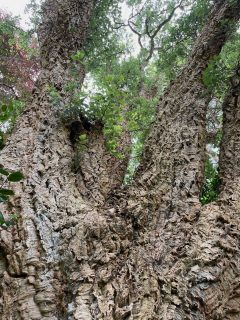
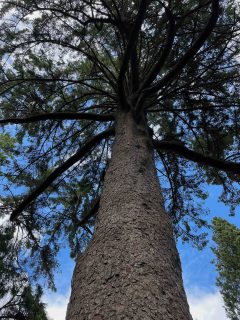
I should also mention the walled garden and greenhouse. The last time I visited (long ago), the 60m long greenhouse was dilapidated and the walled garden almost empty. The restored greenhouse itself is gorgeous and protects an eclectic mix of edibles and decorative plants – apricots, peaches, passion fruit with Lapageria, lilies, a giant honeysuckle and many others. In the centre, the dark stem of a Cyathea tree fern emerges through a removed pane to fan out over the roof.
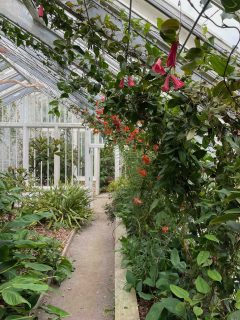
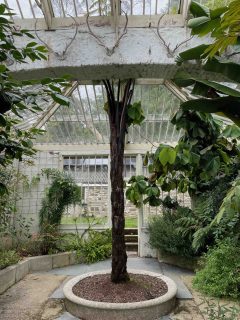
The walled garden is a bit of a disappointment. There has been an attempt at a more formal approach here with a lovely planting of box edged beds of Rosa rugosa alba under a double avenue of white flowered Cornus.
There are some narrow perennial borders in front of the greenhouse but otherwise there are just scattered small trees and lawn. I know that labour-intensive planting is expensive but it seems a bit of a waste of a beautiful space.

The entry into the garden through the tiny tea room and the partially ruined garden buildings is refreshingly uncommercial and the gardeners were well informed and happy to chat about the garden and the trees. I also commend them for selling plants raised in the garden and not bought in.
Summer flowering trees and shrubs
Once again, the dominance of spring-flowering woody plants in Tregrehan and many other Great Cornish Gardens made me wonder why they are so little invested in summer-flowering trees and shrubs.
There are plenty to choose from – even in high to late summer.
The obvious ones:
Hydrangea – we are all familiar – perhaps over familiar with hydrangeas in Cornwall. Many of the commonly seen H.macrophylla are dull blobby things in murky pinkish blueish colours but, if you have these, pull them out and burn them! There are some excellent replacements. I love lacecaps – especially the good strong blues H.macrophylla Zorro – a deep purple blue with dark stems and Tellers Blue – a purer cerulean blue are the ones I’ve chosen. I also like hydrangeas with smaller flower heads so I love H.macrophylla Lanarth White and the H.serrata cultivars, Bluebird with palest silvery blue outer sterile flowers and blue true flowers in the centre and Tiara with pale blue sterile flowers and foliage that turns purple in full sun.
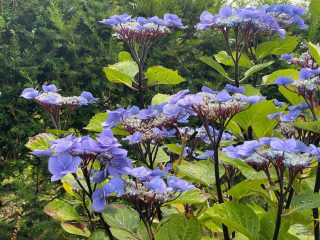
Hydrangea paniculata are the ones with long noses of flowers. My favourite is Limelight which starts a lovely soft green and opens to cream.
Cornish Hydrangeas is a small nursery producing outstanding quality plants. They aren’t open to the public but it’s worth contacting them to find out when they are next at the Truro Farmers market. cornishhydrangeas.co.uk
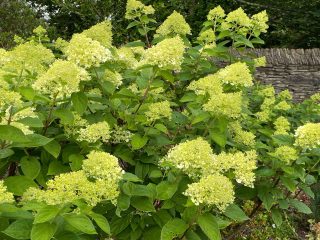
Buddleja – flowering in July and August in time for the main flush of butterflies that flock to them. The most commonly grown species is B. davidii and its hybrids. It’s hard to beat the classic B.Lochinch – a vigorous hybrid with lovely long silvery grey leaves and soft lilac flowers. I’m enjoying a new addition to my Silver Border – B. Black Knight – a very deep purple contrasting well with its pale grey leaves. These benefit from a hard cut back in early spring.
I don’t have it but I’ve always loved B. globosa – which has honey-scented orange balls of flowers and there is a less often seen Lemon Ball version. B. alternifolia is useful in a wilder garden – very tall growing with long drooping inflorescences of pale lilac flowers. All are loved by butterflies.

Mallow family shrubs – so many contribute to long and late summer flowering in our gardens.
Abutilons
Two standout species often seen in Cornish gardens are A.vitifolium – lilac or white flowered and A x suntense -deeper blue flowered. In a sunny spot with shelter from the wind they’ll reward you with flowers from June to September.
Hibiscus syriacus is the hardiest hibiscus. A large shrub or small tree with pink, white or purple flowers in August – September. I’ve seen these looking good trained as blob headed standards growing in pots in courtyards in Italy. As free growing shrubs they can be a bit untidy and twiggy – only coming into their own when flowering. Good cultivars are Blue Bird, Shintaeyang -white with a red eye, Eleonore – a pure white, and Woodbridge – deep pink with a plum eye.
Shrubby Mallows
The shrubby mallows are wonderful, long flowering additions to the summer garden. Lavatera arborea is a lovely wildflower, common on our coast and totally salt tolerant – perhaps we should be growing it in our coastal gardens. L.maritima is more glamorous with larger mauve and cerise flowers and soft grey foliage. It should also be salt tolerant but is definitely more tender – I have lost it just 3/4 of a mile from the sea.
The many variants of L.thuringiaca, L.clementii and their hybrids are very well known and hardy if in well drained soils. Technically a herbaceous perennial but behaving like a semi woody bush, good varieties are Barnsley – pale pink with deeper red pink centre and its baby brother Baby Barnsley; Rosea – a large flowered clear pink, Burgundy Wine – a deep pink with dark stems.
I’ve had a lot of failures with Lavatera in our Roseland garden – winter wet and compacted soils are their enemy. Surprisingly I’ve done much better with Anisodontea capensis – the African Cape Mallow – perhaps because I put it on steep, sunny banks that drain well. This is a dream plant – an evergreen that flowers 12 months of the year! It has 2cm wide, reddish pink flowers nodding from slender stems with small grey green leaves. Softwood cuttings take quite easily. Cutting it back in spring keeps it tidy but it really really hurts to cut it down while it is still churning out the colour.
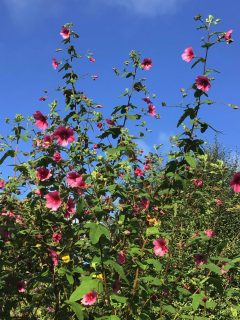
Sphaeralcea incana, a small apricot-flowered shrub mallow from dry regions in central America, also does well here – it is pretty but gets a bit lost in my large borders. There are other Sphaeralceas to try that may have more impact.
Phymosia umbellata – the Mexican bush mallow is a tall shrub or small tree with deep cranberry-red abutilon flowers from July to October and large, evergreen, velvety vine-shaped leaves. Burncoose lists it as half hardy but mine came through last winter’s cold snap without blinking.
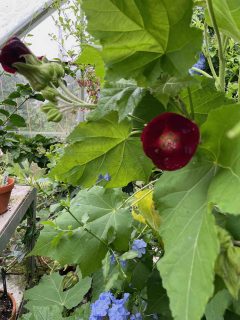
All shrubby mallows are short lived – 3-5 years so take softwood cuttings in summer for replacements.
Hoheria is another genus of large shrubby mallows – this time from coastal New Zealand. There are several garden-worthy species but I favour two. The lovely fully evergreen H.sexstylosa Stardust flowers from mid July through August with masses of small starry white flowers. It can be pruned to shape after flowering or left as a 3m high loose shrub. Burncoose nursery lists it as hardy to -5C but I’ve grown it in North Yorkshire and much colder. I love this so much that I have planted four at Crugsillick.
The other is a hybrid – H.Glory of Almwich which is semi-evergreen and has densely crowded larger white flowers. Both are fine additions to the late summer garden.
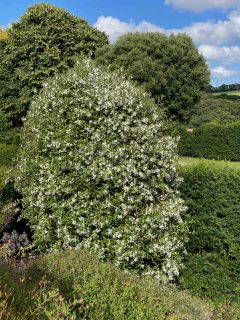
Some of the less obvious ones:
Myrtles – so so many of them but I’ll stick to just two good doers.
Luma apiculata the Chilean myrtle is a potentially tall tree -10-15m high and wide with small evergreen leaves, beautiful cinnamon bark peeling to cream and fragrant white starry flowers in August to September. It also sets clusters of glossy black berries that still look handsome at Christmas. Whats not to like?
Myrtus communis is the common myrtle seen on Mediterranean hillsides. It has small, tidy, evergreen leaves, white scented flowers in July-August and blue black berries. In Sardinia and Corsica an aromatic liqueur is made from its leaves (one of those drinks that is delicious on holiday but loses its appeal once brought home). There are dwarf and variegated versions but I far prefer the ordinary one. It powers up just as the Cistus stop flowering and, like the Cistus, benefits from a cut over to keep it from getting leggy. I don’t understand why it isn’t more widely grown – especially in our coastal gardens.
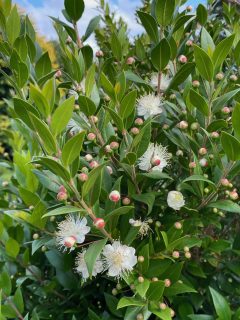
Clerodendron trichotomum is a suckering deciduous shrub/small tree from the Far East. It has some wonderful common names – the Glorytree or the Harlequin Glorybower. The flowers in July-August are scented, white and small but with decorative calyxes and held in large clusters. The ‘harlequin’ descriptor probably refers to the extraordinary fruits which change from cream through clear green to turquoise and finally royal blue inside a bright red star of a calyx. Very easy – in fact a bit of a thug.
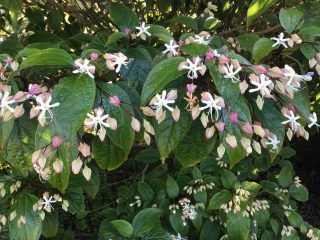
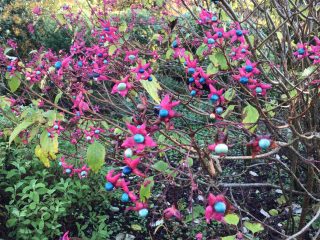
Chitalpa tashkentensis is a hybrid between Chilopsis liniaris the Desert Willow and Catalpa bignonoides– the Indian Bean Tree. This small tree has its desert parent’s long narrow leaves and its other parent’s larger flowers. It needs well drained soil, full sun and protection from strong winds so our site just back from the coast is near perfect. Even so it didn’t flower for five years until I threatened it with eviction – since then it has been reliable. Beautiful pink/white orchid like flowers in panicles in late July and August.
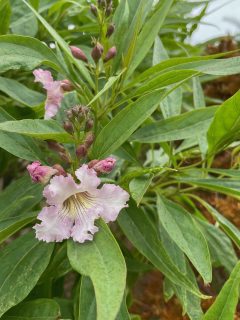
Eucryphias are shrubs and trees from eastern Australia and southern areas of south America. They have tough, leathery evergreen leaves and delicate, four petalled, white or pink flowers with prominent stamens. There are two that are widely. Eucryphia x nymansensis Nymansay which is a tree to growing with a columnar habit to15m. It is highly floriferous – a mass of white flowers in late summer to autumn. The other is Eucryphia lucida – the variety Ballerina and an almost identical one Pink Cloud. Both grow quite slowly with a densely branching habit eventually reaching 8m. My pretty pink ballerinas are huddling behind a yew hedge for protection against the east wind so are growing wider than
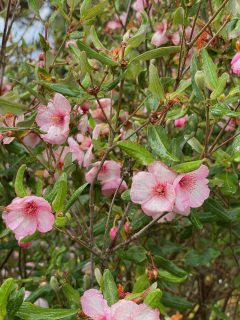
Bupleurum fruticosum – finally, this modest Mediterranean shrub is a member of the cow parsley family. It has evergreen, waxy, simple leaves of a lovely soft grey green on purpley stems. Green/yellow flowers in typical cow parsley umbels are followed by persistent seeds of almost the same colour so it looks decorative for at least 4 months. The rest of the year it just has a quiet cool presence.
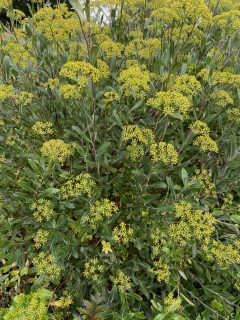
Tregrehan Garden, Par, PL24 2SJ – you will find all the opening times and information here.

